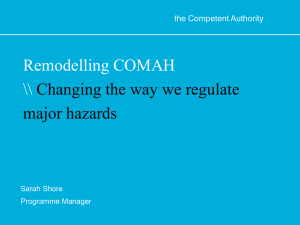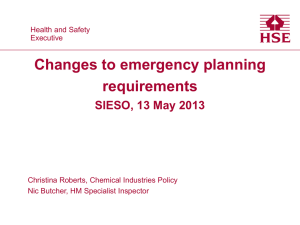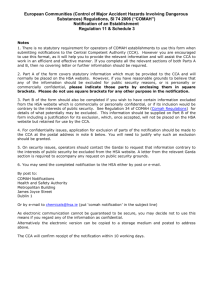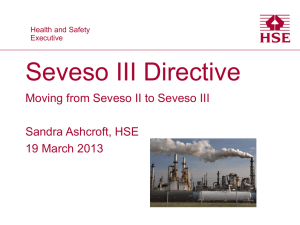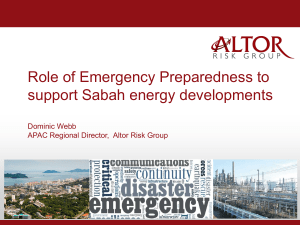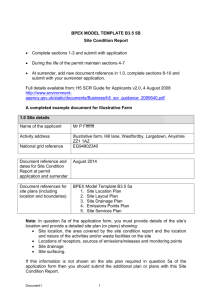COMAH COMPETENT AUTHORITY PROPOSALS FOR IMPLEMENTING
advertisement
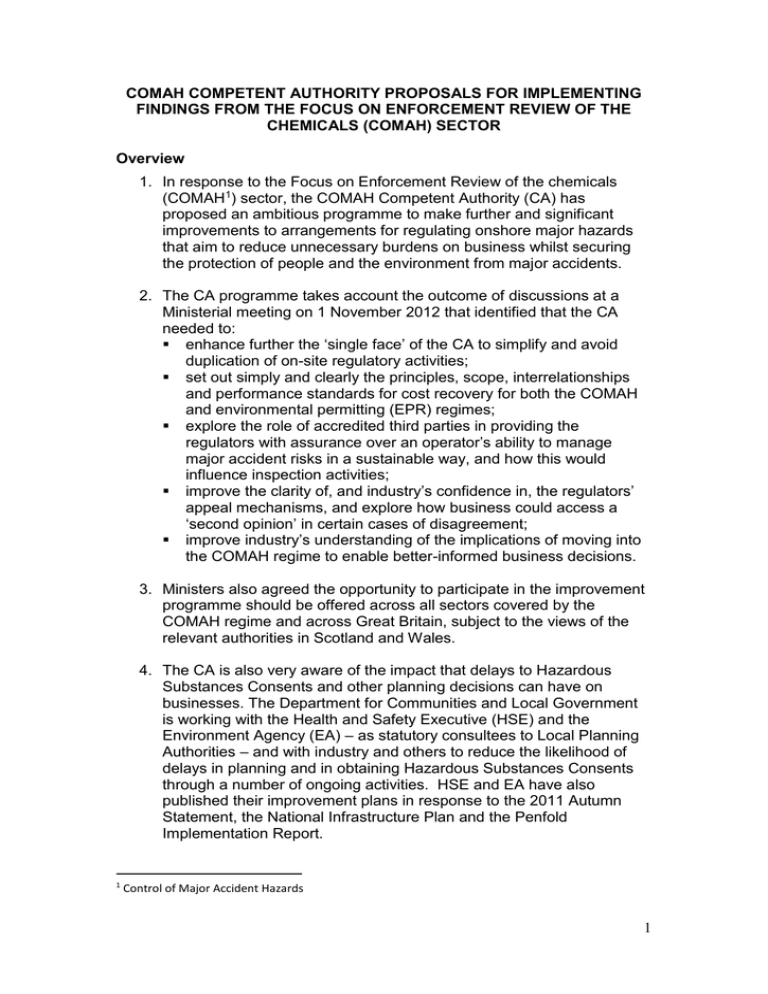
COMAH COMPETENT AUTHORITY PROPOSALS FOR IMPLEMENTING FINDINGS FROM THE FOCUS ON ENFORCEMENT REVIEW OF THE CHEMICALS (COMAH) SECTOR Overview 1. In response to the Focus on Enforcement Review of the chemicals (COMAH1) sector, the COMAH Competent Authority (CA) has proposed an ambitious programme to make further and significant improvements to arrangements for regulating onshore major hazards that aim to reduce unnecessary burdens on business whilst securing the protection of people and the environment from major accidents. 2. The CA programme takes account the outcome of discussions at a Ministerial meeting on 1 November 2012 that identified that the CA needed to: enhance further the ‘single face’ of the CA to simplify and avoid duplication of on-site regulatory activities; set out simply and clearly the principles, scope, interrelationships and performance standards for cost recovery for both the COMAH and environmental permitting (EPR) regimes; explore the role of accredited third parties in providing the regulators with assurance over an operator’s ability to manage major accident risks in a sustainable way, and how this would influence inspection activities; improve the clarity of, and industry’s confidence in, the regulators’ appeal mechanisms, and explore how business could access a ‘second opinion’ in certain cases of disagreement; improve industry’s understanding of the implications of moving into the COMAH regime to enable better-informed business decisions. 3. Ministers also agreed the opportunity to participate in the improvement programme should be offered across all sectors covered by the COMAH regime and across Great Britain, subject to the views of the relevant authorities in Scotland and Wales. 4. The CA is also very aware of the impact that delays to Hazardous Substances Consents and other planning decisions can have on businesses. The Department for Communities and Local Government is working with the Health and Safety Executive (HSE) and the Environment Agency (EA) – as statutory consultees to Local Planning Authorities – and with industry and others to reduce the likelihood of delays in planning and in obtaining Hazardous Substances Consents through a number of ongoing activities. HSE and EA have also published their improvement plans in response to the 2011 Autumn Statement, the National Infrastructure Plan and the Penfold Implementation Report. 1 Control of Major Accident Hazards 1 Outcomes 5. The CA’s action plan means that COMAH operators will: see simplified and, where appropriate, reduced regulatory interactions which avoid unnecessary duplication and overlap between health, safety and environmental regulatory regimes; have a single point of contact in the CA, and know what standards of performance they can expect from the regulators; better understand how the major accident and other hazards they create and their performance in controlling major accident risks influences the scale and depth of regulatory scrutiny they can expect, and how they can provide the regulators with greater assurance about their arrangements for managing and controlling those risks; have greater confidence in the CA’s cost recovery mechanisms for its regulatory activities and better understand the interrelationships between different approaches; have greater confidence in the arrangements for challenging regulatory and cost recovery decisions; be able to make more informed decisions about operating within the scope of the COMAH regime; be involved in the development of any improvements in approach to COMAH Safety Reports. 6. Ministers also supported the CA’s proposals for early and ongoing engagement with industry on the proposed work programme. This will also provide an opportunity to assess the costs and benefits of the improvements along with industry’s capacity to engage with the CA in what will be an ambitions programme of work for all involved. 7. The CA proposes bilateral meetings involving key chemical sector trade associations that contributed to the evidence gathering stage of the BRE Review. These meetings will assist in setting mutual expectations and provide a direction for ongoing engagement. 8. Following clearance by the Reducing Regulation Committee (RRC) and publication of the Review report and the CA’s response, the CA will hold a ’high-level’ stakeholder event comprising a wider segment of industry trade associations and duty holders in scope of the COMAH regulations to agree the overall programme of improvements. Ministers and BRE officials will be invited to attend. 9. The CA also sees this early engagement continuing in the longer term at a strategic level and as a way of involving industry in the transposition of the new Seveso III Directive. 10. The CA and Industry will provide an update on progress to the RRC 6 months into the implementation programme. 2 ACTION PLAN AND TABLE The CA proposes to: 1. Meet with industry representatives of the chemicals sector by the end of January 2013 to: i. Achieve a common understanding of how the improvements to the regime will meet their concerns; ii. Commence discussions on specific topics, i.e. the ‘single face’ of the CA, improving the transparency of cost recovery and appeal mechanisms, and the role of third party verification; iii. Agree the CA’s final improvement programme, and secure industry’s participation in its delivery; and iv. Agree the arrangements for ongoing engagement with the chemicals sector and other COMAH operators, including establishing the proposed COMAH Strategic Forum that will also provide a mechanism to engage industry on the transposition and implementation of the new Seveso III Directive. 2. Work with industry to develop proposals by May 2013 that further simplify, and where appropriate, reduce interactions with business, eliminate any duplication and overlap between health, safety and environmental regulatory regimes, and enhance how the CA acts with a single voice when dealing with business. This will involve: i. Exploring how and in what circumstances health, safety and environmental inspections at lower-risk COMAH establishments can be conducted by just one of the CA partner organisations. The CA will otherwise improve its targeting at higher-risk sites; ii. From April 2013, appointing a single Account Manager with oversight for COMAH and environmental permitting (EPR) site-related regulatory activity at a COMAH site to provide a single interface for such safety, health and environmental regulatory activities. This will be a phased approach starting with Top tier Sites followed by Lower Tier sites; iii. Integrating the planning and delivery of Environmental Permitting (EPR) regulation at COMAH sites within existing CA arrangements for prioritisation and planning by April 2014 so that operators receive a single annual intervention plan for all proactive health, safety and environmental regulation; and iv. Adopting the necessary governance arrangements in the CA Strategic Management Group (CASMG) to deliver these proposals. 3. Work with industry to publish by March 2013 simple, easy-to-understand guides, either separately or as part of a ‘Joint charging book’, that set out for COMAH operators: 3 i. the CA‘s performance standards on service delivery and what industry can expect from the CA, as well as how operators can assist with the delivery of the regulatory regime; ii. how industry can challenge the content, approach to delivery, or outcomes of the CA’s regulatory activity, including how they can obtain a second opinion on certain regulatory decisions; iii. how the regulators determine and recover the costs for the COMAH and EPR regulatory activities and the interrelationships between different approaches, and arrangements for challenging cost recovery decisions; iv. the mechanisms for, and implications of, moving into and out of the COMAH regime to enable operators to make informed business decision; v. the CA will send guide(s) to operators with 2013-14 Intervention Plans in March 2013, and from January 2013 provide information with CA invoices on how to challenge costs; and vi. the CA will publish anonymised data quarterly from January 2013, on the numbers and outcomes of such appeals to provide assurance that industry’s concerns are taken seriously and acted upon. 4. Improve the clarity of how regulatory effort is determined and targeted and provide a clear link between an establishment’s major accident hazard potential and performance and the frequency and depth of inspections. To achieve this the CA will: i. Continue working with industry to develop a common framework for determining sector performance in controlling major accident risk; ii. Work with industry and accreditation bodies (e.g. UKAS) to examine how third party verification could give the regulators the necessary evidence and sustained assurance over operators’ management of major accident risks and how this would influence the CA’s inspection planning; and iii. In the meantime, ’road-test’ an improved methodology that sets out the key characteristics that determine levels of inspection and apply it to intervention planning during 2013/14. 5. Establish by March 2013 a Safety Report Working Group, with representation from industry aimed at exploring in more detail their concerns about the value of the COMAH Safety Report process. The Group will explore the evidence for changing the regulatory approach and, if necessary, recommend by October 2013 process and legislative changes to be taken forward as part of the Seveso III implementation. 4 FOCUS ON ENFORCEMENT REVIEW OF THE CHEMICALS (COMAH) SECTOR – ACTION TABLE Plan Reference Action Description Completion Date 1. Engagement with Industry (i) Hold bilateral discussions with key trade associations about these improvements. 28 February 2013 (ii) Hold a summit with industry to agree fine detail of the reform proposals to ensure it is best tailored to industry needs 28 February 2013 (iii) Agree arrangements for ongoing strategic engagement; including the creation of a Strategic Forum. 28 February 2013 2. Single Face (voice) of the CA (i) Explore how inspections at lower risk COMAH establishments can be conducted by just one of the CA partner organisations. October 2013 (ii) Establish CA Account Managers From April 2013 (iii) Integrate the planning and delivery of Environmental Permitting (EPR) and COMAH regulation at COMAH sites. By April 2014 (iv) Adopt the necessary governance arrangements in the CA Strategic Management Group to deliver these proposals; April 2013 3. Clarifying cost recovery and performance standards and appeals mechanisms (i) Publish a simple ‘what you can expect’ guides for COMAH operators March 2013 (ii) Provide the guide with the 2013-14 Intervention Plans in March 2013, and provide information with CA invoices on how to challenge costs. March 2013 (iii) Set out how industry can challenge the content, approach to delivery, or outcomes of the CA’s regulatory activity (including how they can obtain a second opinion on certain regulatory March 2013 5 decisions). (iv) Set out how regulators determine and recover the costs for COMAH and EPR regulatory activities (Joint charging book); and arrangements for challenging cost recovery decisions. March 2013 (v) Publish quarterly anonymised data on the numbers and outcomes of cost-recovery appeals. From January 2013 (vi) Discuss with industry how we can improve their understanding of the consequences of moving into COMAH (Cliff-edge effect). 28 February 2013 4. Recognition and performance (ii) With industry, develop a common framework for determining sector performance. From April 2013 (ii) Discuss earned recognition with industry prior to discussions with accreditation bodies (e.g. UKAS). 28 February 2013 (iii) Road test and publish by April 2013 a methodology that determine levels of inspection and apply it to intervention planning during 2013/14. From April 2013 5. Review of safety report assessment (i) Establish a Safety Report Working Group. Mar 2013 (ii) SR WG to identify any improvements to then form part of the CA’s programme to implement the Seveso III Directive. By Oct 2013 6

